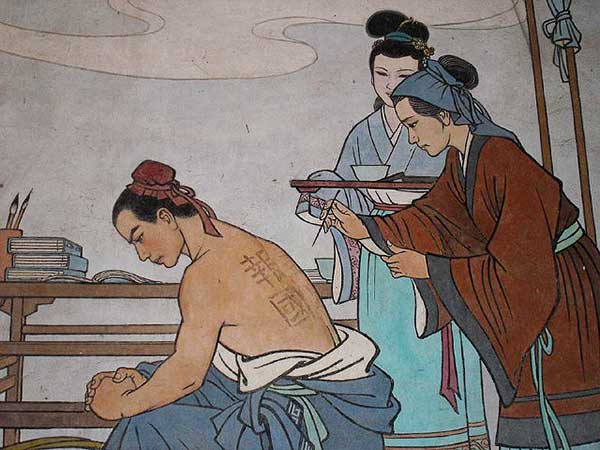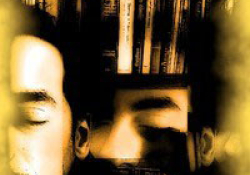Chinese Writing: Dead or Alive?

It is puzzling that the closer China relates to the West, the more the West looks at everything Chinese as “other.” Of course, this mentality has been around for centuries. A common expression is “If you dig a hole through the earth you will end up in China.” I first encountered this saying in F. Scott Fitzgerald’s novel The Great Gatsby. Gatsby’s novel is set in the roaring 1920s, and China was becoming a half-colony fueling American prosperity. But the saying is often taken to be about how the US and China face off on the opposite ends of the global. Culturally, it may also suggest that China is the polar opposite of the US. This is a myth that is being daily generated and sustained.
This myth is particularly interesting in the use of Chinese characters for display. These days people have Chinese characters tattooed on their brawny arms or backs, have them printed on their T-shirts, display them on the door signs, TV ads, and product packaging. These Chinese characters are meant to be nuggets of age-old virtues, such as courage, sincerity, or some axiomatic moral qualities. But such uses of Chinese characters do not necessarily convey meanings to the viewer, who on a street corner or in an elevator may happen to gaze at these signs. Frequently, the persons displaying Chinese characters do not know what they mean, assuming that something inspirational is announced. Absurdly, sometimes people proudly brandish signs of negative meanings on their bodies like badges of glory, like “I am an idiot” or “I am stupid.” Once, in a TV ad, the sign of a brothel, the house of ill repute, is announced as a thriving business. But the meaning of Chinese characters is not the issue here. It is the sheer display of the characters that merits some comments.
With its particles built and inserted into one another, with its strokes flying this way and that, with its labyrinthine but implicitly logical composition, the Chinese character, especially when written in traditional style, seems simultaneously exotic, ancient, modern, postmodern, weird, and mysterious.
It seems that the bearers of “cool” Chinese scripts are more intrigued by the shapes of writing than the meaning. A complicated Chinese character is like an intricately designed building where baroque, radical, modern, and postmodern aesthetics may be jumbled together. With its particles built and inserted into one another, with its strokes flying this way and that, with its labyrinthine but implicitly logical composition, the Chinese character, especially when written in traditional style, seems simultaneously exotic, ancient, modern, postmodern, weird, and mysterious. This mumbo jumbo seems very strange and “other” to uncomprehending eyes. For a person who uses Chinese, however, they are not so elaborate and “other.” They are tools for her to impart and receive meaning, instruments for living daily life. Of course, she may also enjoy the shapes if they are written in a stylized calligraphy. But for communication and practical use, the person who knows Chinese would not brandish and obsessively dwell on the shapes.
Now, how does the fascination with the baroque or postmodern aesthetics of the Chinese character have to do with cross-cultural attitudes? What does this fascination say about one’s habit of perceiving and understanding the unfamiliar? As some scholars have noted, the deployment of the Chinese script with total disregard for signification is premised on a conviction of nonnegotiable differences between Chinese and English. You gaze at the shape and get shocked into silence, which silences the script as well, stripping it of the voice of a living, speaking person. The characters seem untranslatable, and this decorous stonewall invites rather than turns off a prolonged gaze at an utterly opaque, mysterious sign, aggravating all the more the mystique of otherness and remoteness. Even the human qualities built into the language are in question. The Chinese script, in this obsession, becomes the Great Wall of China, alluding to a well-preserved corpse or mummy—elegant, stylistic, yet dead.
The Chinese script, in this obsession, becomes the Great Wall of China, alluding to a well-preserved corpse or mummy—elegant, stylistic, yet dead.
This irrational insistence on a mystified Chinese difference, a mummified essence, occurs not only with people who do not know a word of Chinese. Even scholars who study Chinese language and culture tend to enshrine Chinese characters in an ancient tomb.
This moribund fascination with Chinese characters as a living corpse is very puzzling. What anxiety drives people in the US to stare at China as an icon, something that does not need to be understood in its living modern history? Why, in this age of global connection and deepening ties between nations, and after all revolutions, reforms, and modernization, does this fascination still relegate Chinese culture to the twilight zone of the undead? Economically and financially, China is pumping so much life into the world economy. In the past century of social and political transformation, China has also transformed the Chinese language. In its actual usage, the Chinese language is animated with living impulses, voice, and fluidity. It is a language shaped by cool scripts and animated by living voices. The fascination may be riding on the tide of the “China cool,” but seems also inclined to put the genie back into the bottle.
Stanford University








